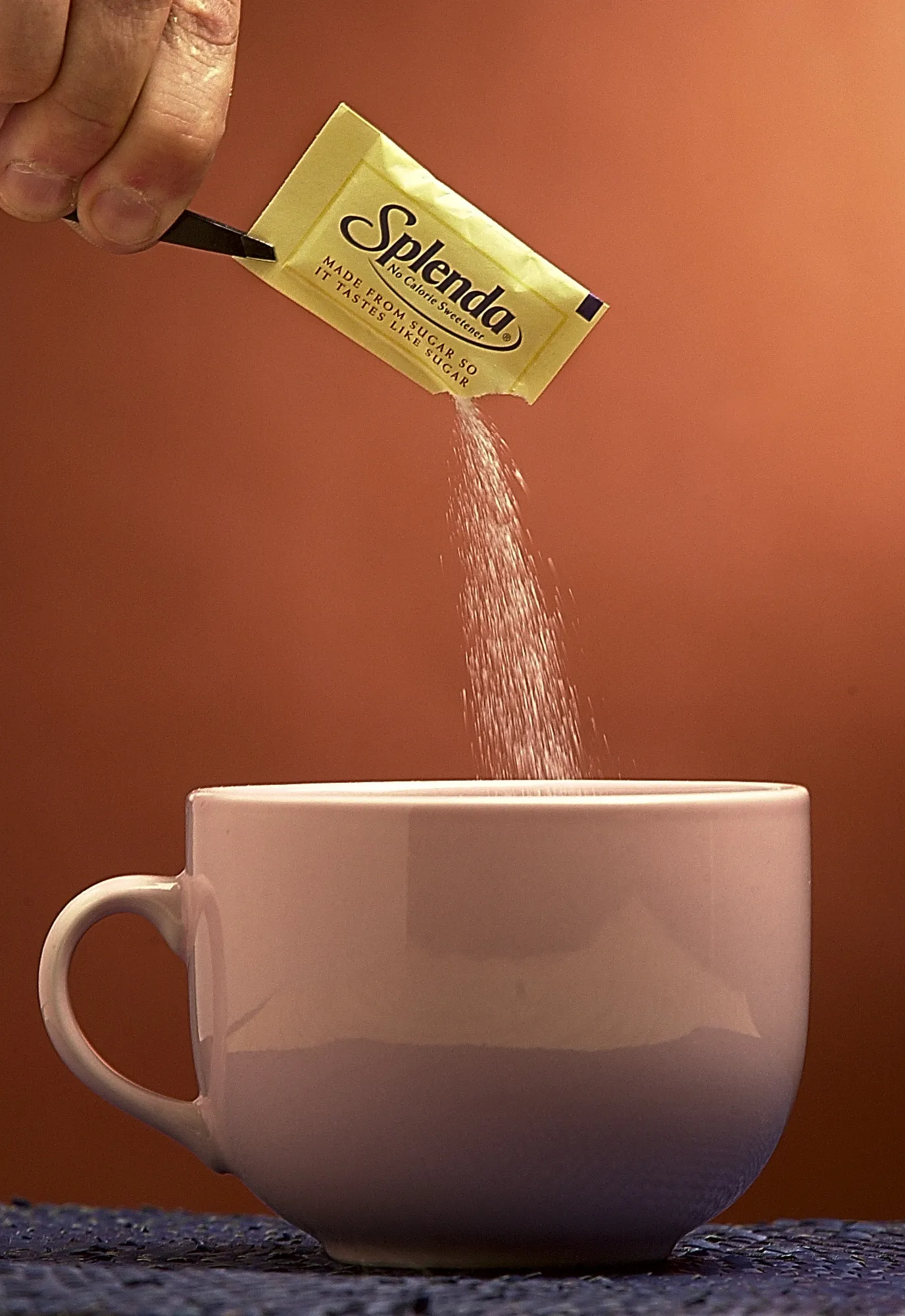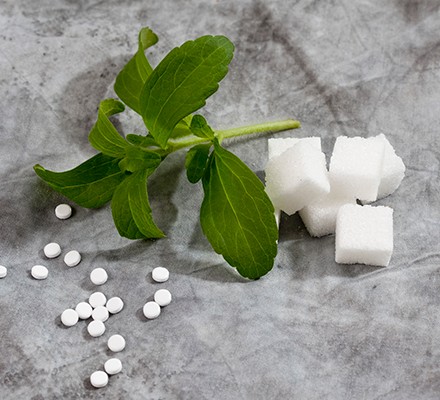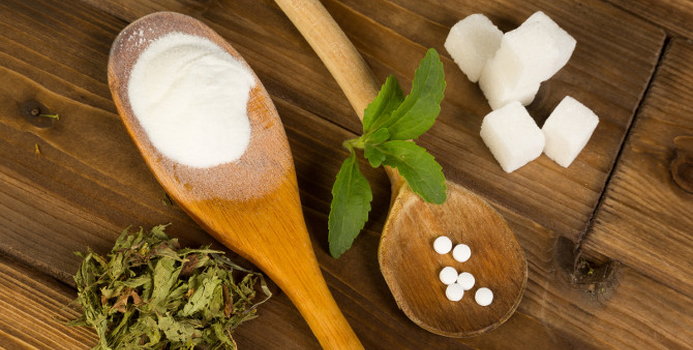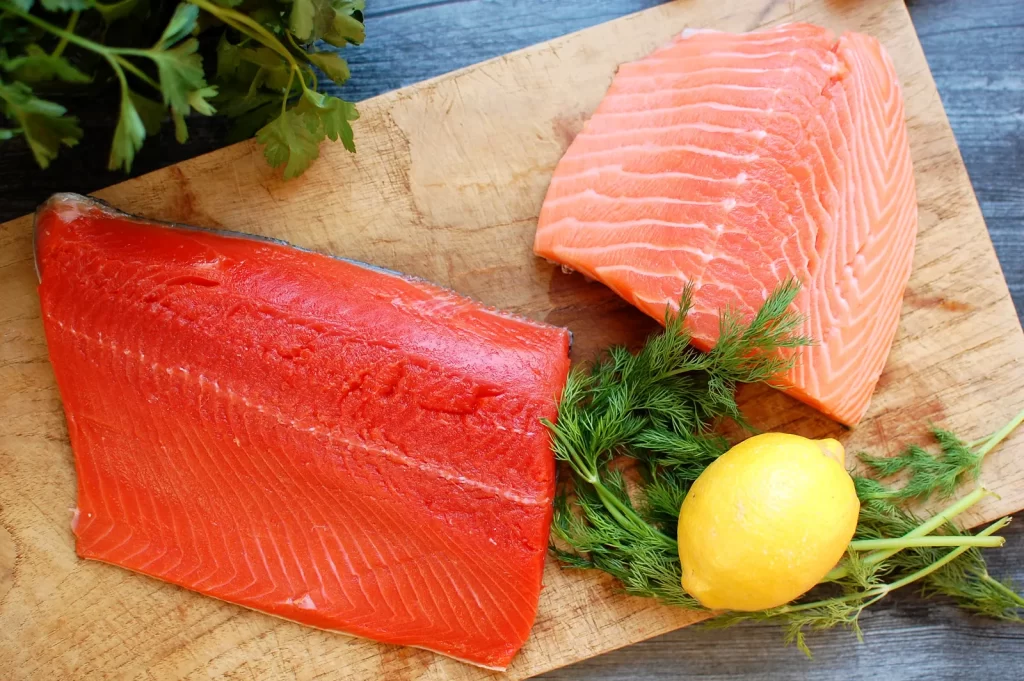Splenda and Stevia are two popular sugar substitutes widely used in a variety of food products and beverages. Splenda, known chemically as sucralose, is an artificial sweetener created through a process that begins with sugar and modifies it to create a calorie-free sweetener.
On the other hand, Stevia is a natural sweetener derived from the leaves of the Stevia rebaudiana plant. It’s known for its ability to provide sweetness without the calories found in sugar. While Splenda is heat-stable and often used in baking and cooking, Stevia is sometimes noted for having a slight aftertaste but is preferred by those looking for a natural alternative.
Both sweeteners offer the benefit of sweetness without the caloric intake of sugar, making them popular choices for individuals managing diabetes or those seeking to reduce sugar intake.
What is Splenda?
Splenda is a brand name for a sweetener made primarily from sucralose. Sucralose is an artificial sweetener, which means it is synthesized in a laboratory, and not found naturally. It is made through a multi-step process where three hydrogen-oxygen groups on a sugar (sucrose) molecule are replaced with three chlorine atoms. This alteration creates a substance that is about 600 times sweeter than sugar but without the calories.

Splenda is used in a wide range of food products as a sugar substitute, including beverages, baked goods, and candies. It’s popular because it doesn’t have the bitter aftertaste that some other artificial sweeteners do. Additionally, it’s heat-stable, which makes it suitable for cooking and baking. Another advantage of Splenda over some other sweeteners is that it doesn’t affect blood glucose levels, which makes it a safer choice for people with diabetes.
Splenda is available in various forms, such as granulated for baking and small packets for sweetening drinks. While it is considered safe by health authorities like the U.S. Food and Drug Administration (FDA), some people choose to avoid artificial sweeteners due to personal health concerns or preferences for natural products.
What is Stevia?
Stevia is a natural sweetener and sugar substitute derived from the leaves of the plant species Stevia rebaudiana, native to Brazil and Paraguay. The key compounds in Stevia that provide its sweetness are steviol glycosides, primarily stevioside and rebaudioside, which can be up to 300 times sweeter than table sugar (sucrose), yet contain no calories.

Unlike artificial sweeteners like sucralose (found in products like Splenda), Stevia is plant-based, making it a popular choice for those seeking natural sweetener options. Stevia is widely used in a variety of foods and beverages, including teas, soft drinks, juices, and as a tabletop sweetener. It’s also used in some health and dietary products, owing to its low-calorie profile, making it a favorable option for weight management and individuals with diabetes, as it does not significantly impact blood glucose levels.
The safety of Stevia has been evaluated and confirmed by various global health and regulatory organizations, including the U.S. Food and Drug Administration (FDA), which has labeled high-purity Stevia extracts as Generally Recognized as Safe (GRAS). Raw or crude Stevia extracts and leaves are not FDA-approved, and the commercial Stevia sweeteners available in the market are highly purified and processed forms of the plant’s extracts.
Comparison table of Splenda vs Stevia
Here’s a comparison table highlighting the key differences between Splenda and Stevia:
| Feature | Splenda (Sucralose) | Stevia |
|---|---|---|
| Origin | Synthetic (artificial) | Natural (plant-based) |
| Source | Modified sugar molecule | Stevia rebaudiana plant |
| Sweetness | About 600 times sweeter than sugar | About 200-300 times sweeter than sugar |
| Calories | Zero or low-calorie | Zero-calorie |
| Taste | Similar to sugar, no bitter aftertaste | May have a slight licorice-like or bitter aftertaste |
| Heat Stability | Stable under high heat, suitable for cooking and baking | Generally stable, but some forms may degrade at very high temperatures |
| Blood Sugar Impact | Minimal to no effect on blood sugar | No effect on blood sugar |
| Regulatory Status | Approved by major health authorities including FDA | Generally recognized as safe (GRAS) by the FDA |
| Usage | Widely used in processed foods, beverages, and for home cooking/baking | Commonly used in beverages, sweet treats, and as a table sweetener |
| Health Concerns | Considered safe, but some concerns about long-term effects and digestive discomfort | Considered safe, preferred by those seeking natural alternatives |
Remember, individual preferences and sensitivities can vary, so the choice between Splenda and Stevia often comes down to personal taste and health considerations.
Possible Side Effects and Health Concerns
Both Splenda (sucralose) and Stevia have been generally recognized as safe by major health authorities, but like any food additives, they may have potential side effects or raise health concerns for some individuals.
Here are some possible side effects and health concerns associated with both sweeteners:
Splenda (Sucralose)
- Digestive Issues: Some people report experiencing bloating, gas, or diarrhea after consuming sucralose, particularly in large amounts.
- Allergic Reactions: Though rare, there have been reports of allergic reactions to sucralose.
- Effect on Gut Bacteria: Some animal studies have suggested that sucralose may hurt gut bacteria, but the relevance of these findings to human health is not clear.
- Cooking at High Temperatures: When used at high temperatures, sucralose can break down into potentially harmful substances. However, this is more of a concern at temperatures higher than those typically used in home cooking.
- Long-term Effects: While short-term studies support its safety, some health experts call for more long-term research to fully understand its effects.
Stevia
- Bitter Aftertaste: Some individuals may experience a bitter or licorice-like aftertaste, which is a sensory rather than a health concern.
- Gastrointestinal Symptoms: Similar to other non-nutritive sweeteners, consuming Stevia in large amounts may lead to digestive issues like nausea or bloating.
- Allergic Reactions: Allergic reactions to Stevia are rare but possible, especially in those who are allergic to other members of the Asteraceae/Compositae family (like ragweed, chrysanthemums, marigolds, daisies).
- Blood Pressure and Blood Sugar Effects: Stevia might lower blood sugar and blood pressure, which is generally positive but could be a concern for individuals with hypoglycemia or those on certain medications.
- Regulatory History: Stevia’s regulatory history, particularly concerning its raw leaf and crude extract forms, has been more complex, although high-purity Stevia extracts are generally recognized as safe.
- Pregnancy and Breastfeeding: While generally considered safe, the lack of extensive research means that pregnant and breastfeeding women might choose to be cautious with its use.
It’s important to remember that everyone’s body reacts differently to different substances, and what causes side effects in one person may not in another. Moderation is key, and those with specific health concerns or conditions should consult with a healthcare provider before incorporating these sweeteners into their diet regularly.
Pros and Cons of Splenda
Splenda, known chemically as sucralose, is a popular artificial sweetener used as a sugar substitute. Here are some of the pros and cons associated with its use:
Pros of Splenda
- Zero Calories: Splenda provides a sweet taste without the calories associated with sugar, which can be beneficial for weight management and calorie control.
- Safe for Diabetics: It does not have a significant impact on blood glucose levels, making it a suitable sweetener for people with diabetes.
- Heat Stable: Unlike some other sweeteners, Splenda is stable at high temperatures, making it versatile for cooking and baking.
- No Dental Decay: It does not contribute to tooth decay since it’s not broken down by mouth bacteria like sugar.
- Long Shelf Life: Splenda has a long shelf life and does not degrade easily over time.
- Taste: It’s often favored for its taste, which is closer to that of sugar compared to many other artificial sweeteners, without a bitter aftertaste.
Cons of Splenda
- Artificial Chemical Composition: Some people prefer to avoid Splenda due to its synthetic nature.
- Digestive Issues: Consuming large amounts of Splenda may lead to digestive issues for some people, such as bloating, gas, and diarrhea.
- Potential Health Concerns: There are ongoing debates and studies about the long-term health effects of consuming artificial sweeteners, including Splenda.
- Environmental Impact: The production and disposal of artificial sweeteners may have environmental impacts that are a concern for some individuals.
- Not Suitable for All Recipes: Although heat-stable, the sweetness profile of Splenda can change in certain baking and cooking applications.
- Possible Interference with Gut Bacteria: Some studies in animals have suggested that Splenda might negatively affect gut bacteria, though the implications for human health are not fully understood.
Health and regulatory agencies like the U.S. Food and Drug Administration (FDA) have deemed Splenda safe for general use. Individual preferences and tolerances can vary, so it’s always a good idea to consult with a healthcare provider if you have specific health concerns or dietary needs.
Pros and Cons of Stevia
Stevia, a natural sweetener derived from the leaves of the Stevia rebaudiana plant, has gained popularity as a sugar substitute. Like all food additives, it has its pros and cons:
Pros of Stevia
- Natural Origin: Derived from a plant, it is often preferred by those seeking natural alternatives to artificial sweeteners.
- Zero Calories: Stevia provides sweetness without calories, making it beneficial for weight management and those monitoring their caloric intake.
- Safe for Diabetics: It does not raise blood sugar levels, making it a suitable sweetener for people with diabetes.
- Dental Health: Stevia does not contribute to tooth decay, as it is not fermented by mouth bacteria.
- Stable at High Temperatures: Generally, it is stable for cooking and baking, though some forms may degrade at very high temperatures.
- May Have Health Benefits: Some studies suggest Stevia might have additional health benefits, such as lowering blood pressure and having anti-inflammatory properties.
Cons of Stevia
- Aftertaste: Some people detect a bitter or licorice-like aftertaste, which can be off-putting.
- Variability in Sweetness: The quality and sweetness of Stevia can vary depending on the brand and the specific extract used.
- Limited Research on Long-Term Effects: While generally recognized as safe, the long-term effects of Stevia are not as extensively researched as some other sweeteners.
- Processing Concerns: While the Stevia plant is natural, the commercial extraction and processing methods might involve chemicals, which concerns some individuals.
- Allergic Reactions: Rare, but possible, particularly for those who are allergic to related plants in the Asteraceae family.
- Interaction with Medications: Stevia may interact with certain medications, especially those for diabetes and blood pressure, due to their potential effects on blood sugar and blood pressure levels.
Stevia is widely considered safe for general use, and it’s approved by major health organizations like the U.S. Food and Drug Administration (FDA). As with any dietary choice, individual responses can vary, and it’s always wise to consult a healthcare professional if you have specific health concerns or conditions.
Culinary Uses of Splenda vs Stevia
Splenda (sucralose) and Stevia are both sweeteners that can be used in various culinary applications, but they have some differences in their usage due to variations in sweetness and properties.
Here are the culinary uses of Splenda and Stevia:
Culinary Uses of Splenda:
- Beverages: Splenda can be used to sweeten beverages such as coffee, tea, iced tea, and lemonade. It dissolves easily in both hot and cold liquids.
- Baking: Splenda is suitable for baking and can be used in recipes for cakes, cookies, muffins, and more. However, it’s essential to use Splenda products specifically designed for baking and follow conversion charts, as it is much sweeter than sugar. Keep in mind that Splenda may not provide the same texture and browning properties as sugar in baked goods.
- Cooking: Splenda can be used in cooking to sweeten sauces, dressings, and marinades. It is heat-stable and can withstand cooking temperatures.
- Desserts: Splenda is used in recipes for puddings, custards, and fruit desserts. It can be an excellent choice for those looking to reduce sugar content in their sweet treats.
- Yogurt and Oatmeal: You can mix Splenda into plain yogurt or sprinkle it over oatmeal to add sweetness without adding calories.
- Chilled Desserts: Splenda can be used in recipes for chilled desserts like gelatin-based desserts and no-bake cheesecakes.
- Smoothies: Add Splenda to homemade smoothies and shakes for added sweetness.
Culinary Uses of Stevia:
- Beverages: Stevia is commonly used to sweeten beverages such as tea, coffee, iced tea, and homemade lemonade. It’s much sweeter than sugar, so a small amount goes a long way.
- Baking: Stevia can be used in baking, but it’s crucial to use a Stevia product specifically designed for this purpose. Follow conversion charts to adjust the quantity, as Stevia is significantly sweeter than sugar. Keep in mind that Stevia may not provide the same texture and browning properties as sugar in baked goods.
- Fruit Desserts: Stevia is well-suited for sweetening fruit-based desserts like fruit salads, fruit compotes, and fruit tarts.
- Yogurt and Oatmeal: Mix Stevia into plain yogurt or sprinkle it over oatmeal to add sweetness without additional calories.
- Sauces and Dressings: Stevia can be used to sweeten homemade salad dressings, marinades, and sweet sauces.
- Cereals and Granola: Sprinkle Stevia on cereals, granola, or muesli to enhance the flavor of breakfast dishes.
- Jams and Preserves: Stevia is suitable for making low-sugar or sugar-free jams and preserves.
- Smoothies: Add Stevia to homemade smoothies and shakes for a sweet flavor without extra calories.
When using Splenda or Stevia, it’s essential to follow recommended serving sizes or conversion guidelines provided by the manufacturer, as they are much sweeter than sugar.
What are the Similarities between Splenda vs Stevia?
Splenda (sucralose) and Stevia have several similarities, particularly in their roles as sugar alternatives.

Here are some key points where they overlap:
- Purpose as Sugar Substitutes: Both Splenda and Stevia are used as alternatives to sugar. They are designed to provide sweetness without the calories and blood sugar spikes associated with regular sugar.
- Calorie-Free: Both sweeteners are considered to be calorie-free, making them popular choices for weight management and those monitoring their caloric intake.
- Suitability for Diabetics: Splenda and Stevia do not significantly affect blood glucose levels, making them suitable options for people with diabetes who need to manage their blood sugar levels.
- Wide Range of Use: Both are versatile and can be used in a variety of food and drink products, including beverages, baked goods, and desserts.
- Non-Cariogenic: They do not contribute to tooth decay, as they are not fermented by the bacteria in the mouth like sugar is.
- Availability: Both are widely available in grocery stores and are sold in various forms, such as granules, packets, and liquid drops, for both cooking and tabletop use.
- FDA Approval: In the United States, both Splenda and Stevia have been approved by the Food and Drug Administration (FDA) for general use as sweeteners.
- Taste: While they have different flavor profiles, both aim to mimic the sweetness of sugar while avoiding its caloric content.
Despite these similarities, it’s important to note that they differ in origin (synthetic vs. natural), taste, and chemical composition, which can influence consumer preferences and choices.
Conclusion
Splenda and Stevia are popular sugar substitutes, each with unique attributes catering to different preferences and needs. Splenda, a synthetic sweetener known as sucralose, is favored for its sugar-like taste and versatility in both cooking and baking, offering a calorie-free alternative without significantly affecting blood sugar levels. Stevia, derived from the Stevia rebaudiana plant, appeals to those seeking a natural sweetener and is calorie-free and safe for diabetics.
It may impart a distinctive aftertaste and behave differently than sugar in baking. Both are excellent choices for reducing sugar intake, but their differences in origin, taste, and culinary performance guide consumer preference, underlining the importance of personal taste and dietary requirements in choosing the most suitable sweetener.


